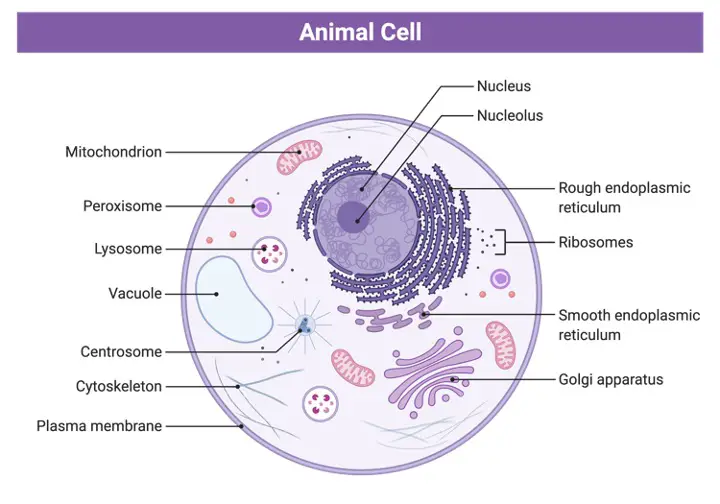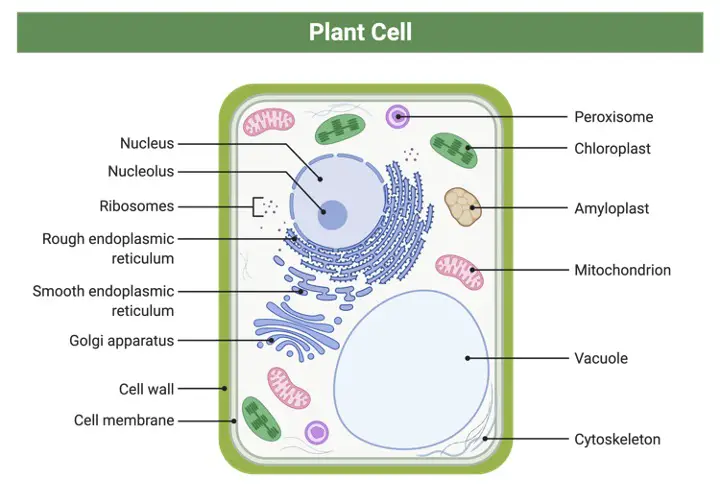Table of Contents
Eukaryotes Definition
Any organism that is mainly characterized by a cell with one or more distinct nuclei at least once in its lifetime can be included in the category of eukaryotes.
Eukaryotes Etymology
The term eukaryote (plural: Eukaryotes) is a derived word Greek words ‘eu’ (good/well/true) + ‘kary’ (nut/kernel). The term eukaryotic is used very often to refer to eukaryote.
What are Eukaryotes?
Eukaryotes, whether single-celled or multicellular organisms are characterized by the presence of distinct, membrane-bound nuclei inside the cell. Some organisms have cells with compartmentalized structures i.e., organelles such as the nucleus. Hence, they are examples of eukaryotes.
Eukaryotes are different from prokaryotes due to the presence of distinct nuclei enclosed within membranes. Cytoplasmic organelles such as mitochondria, chloroplasts, and Golgi bodies are also uniquely present in eukaryotes. Another distinct characteristic of eukaryotes is the presence of flagella made up of microtubules in a 9+2 arrangement.

In eukaryotic organisms, the cell has several membrane-bound structures called organelles suspended in the cytoplasm. Nucleus, mitochondrion, Golgi apparatus, endoplasmic reticulum, and plastid are major organelles found in a eukaryotic cell. Other cellular organelles include cytoskeleton, inclusions, and biomolecules. These organelles have their distinct functions, they are involved in various metabolic activities that help in regulating homeostasis.

Cells of eukaryotes can undergo two kinds of division: Mitosis and Meiosis. In mitosis, a diploid cell divides to give rise to two diploid daughter cells, while in meiosis four haploid daughter cells are formed after two consecutive divisions. In males, the haploid cell grows into a sperm cell (spermatozoan) whereas, in females, it could grow into an egg cell (ovum).
These two haploid cells also known as gametes, unite via fertilization and produce a diploid zygote. In multicellular eukaryotes, the zygote divides via mitosis to produce stem cells that further develop and differentiate into specialized cells. These specialized cells form tissues, organs, and organ systems to perform a particular function.
In humans, there are several specialized cells like adipocytes, neurons, blood cells, hepatocytes, osteocytes, etc. In some unicellular eukaryotic organisms, a single cell is capable of performing all important functions like ingestion, respiration, excretion, osmoregulation, etc. These single-celled organisms are categorized as protists.
Prokaryotes vs Eukaryotes
Organisms with cells that lack a distinct nucleus and membrane-bound organelles are known as prokaryotes. They have greater metabolic rates as compared to eukaryotes because of the greater surface area to volume ratio. The prokaryotic cell is smaller in size than the eukaryotic cell. Prokaryotes have circular DNA. E.g. Eubacteria and Archaea.
Eukaryotes have nuclear DNA in their nucleus. The distinct nucleus has a nuclear membrane of a lipid bilayer with perforated nuclear pores. Eukaryotes have linear strands of DNA inside the nucleus that is tightly packed into chromatin with the help of histone proteins. Chromatin condenses into chromosomes when the cell starts dividing.
The genetic information of both eukaryotes and prokaryotes is stored in genes. Both have ATP as their main source of energy. Both of them also have ribosomes which play an important role during protein synthesis. However, ribosomes in eukaryotes are 80S ribosomes while prokaryotes have 70S ribosomes.
Both prokaryotic and eukaryotic ribosomes are made up of two subunits. The prokaryotic ribosome is consists of 50S and 30S while the eukaryotic ribosome is made up of 60S and 40S. (Note: The S units represent measures of sedimentation rate, not mass. Hence, they do not add up)
Eukaryotes Examples
All eukaryotes included in Domain Eukarya. Organisms belonging to this domain are as following:
Animals: Animals are distinct from other eukaryotes because they are heterotrophic, motile, and multicellular. Their body is well organized into cells, tissues, organs, and organ systems. The cells lack cell walls and chloroplasts, and they grow from a blastula during embryonic development.
Plants: Plants are eukaryotes that have chlorophyll and other pigments to help in photosynthesis. Plant cells have a cell wall that is mainly made up of cellulose which provides structural support. They do not show motility as shown by animals. They have limited movement but have the capability of unlimited growth through meristematic tissues. They do not have sense organs but can sense certain stimuli and respond accordingly via a limited movement known as tropisms.
Fungi: Fungi have cell walls that mainly consist chitin. Fungi are heterotrophic as they lack chlorophyll. Most of the fungi are multicellular, with hyphae and mycelium. Many of them are multicellular, forming hyphae and mycelium, while few are unicellular. E.g. Yeasts, mildews, puffballs, truffles, molds, and mushrooms.
Protists: Protists are the only group of unicellular eukaryotes. However, few species can form filaments or colonies. Some of them have organs such as pseudopods, cilia, and flagella for locomotion and hence are motile. Others are non-motile because of the lack of these organs. Protists include the following:
- Protozoa: Animal-like protists
- Algae: lant-like protists
- Slime molds and water molds: Fungus-like protists.







